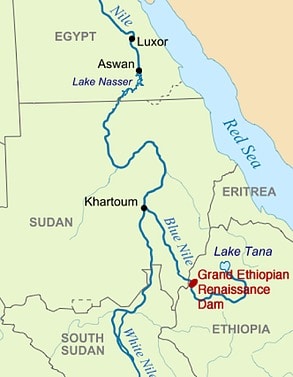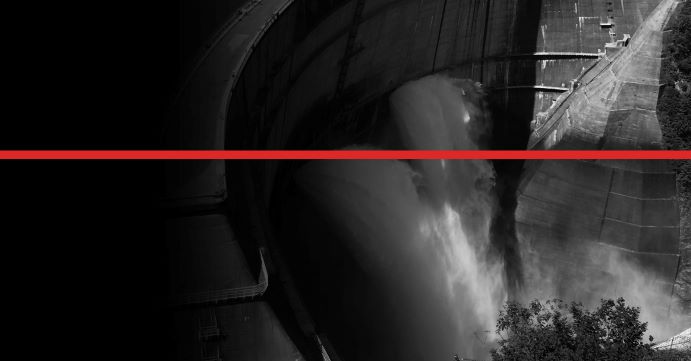Intro: Grand Ethiopian Renaissance Dam
Currently, the talks between Ethiopia, Sudan and Egypt failed to reach a consensus on the Grand Ethiopian Renaissance Dam (GERD). These technical reports are necessary to complete the agreement between the three states on the GERD. However, it is probable that Ethiopia will fill the reservoir before the technical reports are finalised.
Furthermore, following the latest meetings on November 12th. Egyptian officials have expressed concerns about the unilateral decision to fill the GERD reservoir. Meanwhile, a final agreement was reached before the reports were completed. Should this filling proceed, it would put a severe strain on relations between Egypt and Ethiopia.

Currently, the dam is two-thirds completed, and it is set to be the largest in Africa. However, it has raised concerns on its impact downstream, particularly in Egypt. The Nile provides Egypt with nine-tenths of its water supply. More than half of the water in the Nile stems from the Blue Nile.
Cairo is concerned that the Dam presents a threat to the continued supply of water. As per the 1959 Nile Waters Agreement. The 1959 agreement awarded a majority of the water flow to Egypt and the rest to Sudan. Furthermore, it gave veto powers over upstream dam-building to Egypt.
The 2015 ‘Declaration of Principles’
However, this agreement was replaced in 2015 by a preliminary deal, four years after Grand Ethiopian Renaissance Dam construction began. The 2015 ‘Declaration of Principles was signed by Egypt, Sudan and Ethiopia, and it consists of ten principles. According to Hani Raslan of the Al-Ahram Center for Political and Strategic Studies. The declaration itself only requires its signatories to respect the principles. As such, there is no legally binding framework, which Ethiopia needs to adhere to.
For example, the Declaration of Principles also ties the filling process to the technical reports. However, the politico-diplomatic deadlock prevents issuance. In order to circumvent this, Ethiopia separates the filling process into two stages. First, a ‘first filling’ aimed at filling the reservoir enough to drive two turbines. Second, a ‘complete filling’ that would see the reservoir filled to its capacity of 74 billion cubic metres of water.[1] So, by only linking the ‘complete filling’ to the technical reports, Ethiopia can make a case for filling the reservoir.
The Grand Ethiopian Renaissance Dam would upset the current balance of power in the region. The 2015 declaration prevented the breakout of war after the first third of construction of the dam was completed. Egypt has previously threatened to go to war over the construction of dams, until the Arab Spring of 2011. While Egypt was dealing with its domestic situation. Ethiopia commenced building the dam which has the potential to upset the economic relationships in the area.
Ethiopia’s Quest for “Power”
For example, the Dam will provide 6,000 megawatts of power. Enough for Ethiopia to export energy on a planned east African power grid. More urgently, filling the reservoir presents a danger to Egypt. Since filling the reservoir would divert water destined for use in Egypt. This is problematic because Egyptian water consumption per capita is already one of the lowest in the world.[2]
Therefore, the issue of GERD is more acute for Egypt than for Sudan. Currently, Sudan only takes two-thirds of what it is allotted in the 1959 agreement. The dam would allow Sudan to draw water for irrigation around the year. Rather than in a pattern determined by the episodic flow of the Blue Nile. This would increase the water drawn by Sudan, and by extension reduce the amount of water that reaches Egypt.
Furthermore, to further compound the issue Sudan was divided in 2011 into Sudan and South Sudan. The treaty that divided Sudan made no mention of the water rights to the Nile. Subsequently, opening an opportunity Egypt has thankfully pounced on. By supporting the South Sudanese development of water resources, Egypt propels South Sudan to secure rights to its portion of the Nile – which Egypt, in turn, can buy from South Sudan.
Hair-Trigger on the Grand Ethiopian Renaissance Dam
In conclusion, with Egyptian allegations that Ethiopia is using the talks as a cover to delay the technical reports until construction is finalised. The political situation is poised for conflict. The signing of the Declaration of Principles confirms Cairo has committed to a diplomatic solution, especially since the rise of Sisi. However, the continued delay of talks and concerns that Ethiopia could begin a ‘first filling’ unilaterally puts pressure on Egypt. That is to say, should Ethiopia succeed in finalising the dam and commence filling of the reservoir, it would signal the end of Egypt’s hegemony in the Nile Basin and put relations between Egypt and Ethiopia on a hair-trigger.
———————-
[1] For a frame of reference, the Egyptian annual share of the Nile’s water amounts to 55 billion cubic metres.
[2] The listed rate is 660 cubic square metres per capita, which is approximately half of the global annual average.

